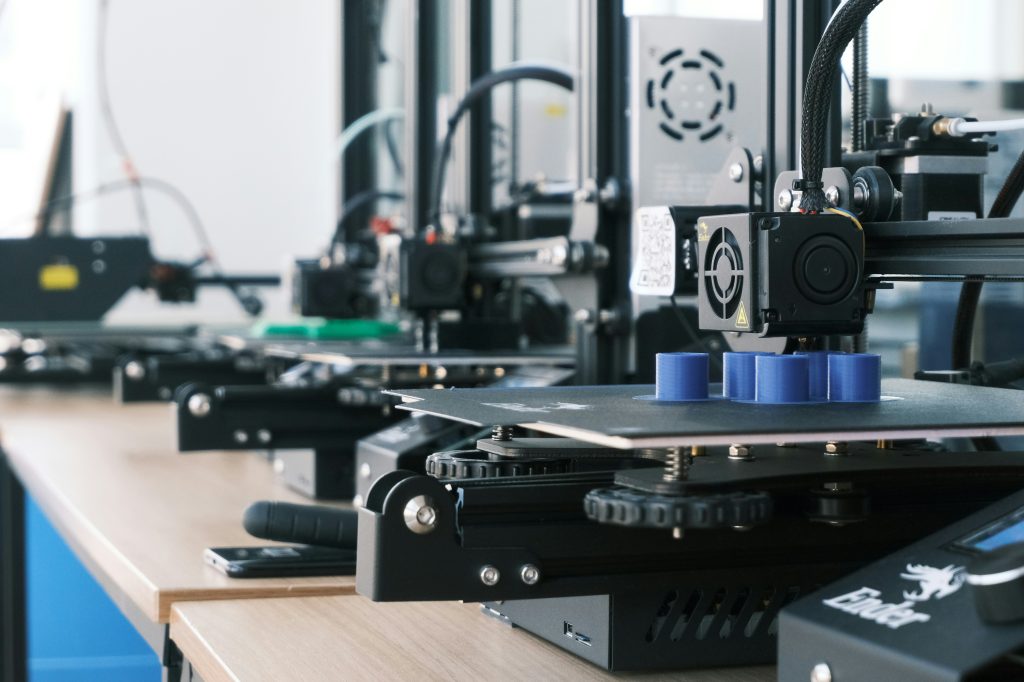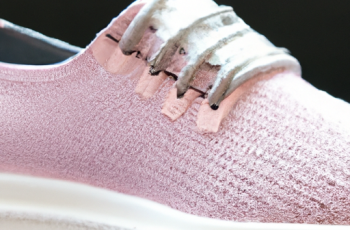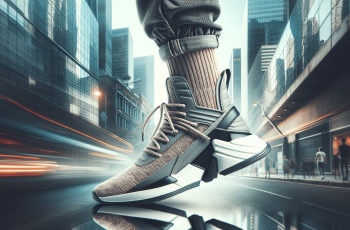Imagine walking into a sneaker store and being able to customize your very own pair of knit sneakers, tailored precisely to your style and comfort preferences. This may sound like a dream, but thanks to the advancements in 3D printing technology, it is becoming a reality. 3D printing has revolutionized the way sneakers are designed and produced, particularly when it comes to knit sneaker designs. In this article, we will explore the role of 3D printing in crafting these innovative and stylish sneakers, and how this technology is reshaping the future of the footwear industry. So get ready to step into a world where customization and creativity come together in the form of 3D printed knit sneakers.

Benefits of 3D Printing in Crafting Knit Sneaker Designs
Enhanced Design Freedom
One of the major benefits of using 3D printing technology in crafting knit sneaker designs is the enhanced design freedom it offers. Traditional manufacturing methods often come with limitations in terms of design possibilities due to the constraints of molds and tooling. With 3D printing, however, designers have the freedom to create intricate and complex designs that were previously impossible or highly difficult to produce. This opens up a world of possibilities for creating unique and visually stunning knit sneaker designs.
Customization and Personalization
Another significant advantage of utilizing 3D printing in knit sneaker design is the ability to customize and personalize each pair of sneakers. With traditional manufacturing methods, creating custom-fit footwear can be costly and time-consuming. However, 3D printing allows for the precise tailoring of sneakers to an individual’s specific measurements and foot shape. This level of customization not only enhances the comfort and fit of the sneakers but also provides a truly personalized product that meets the unique preferences and requirements of each customer.
Improved Manufacturing Efficiency
3D printing technology in knit sneaker design also brings improved manufacturing efficiency. Compared to traditional manufacturing techniques that often involve multiple steps and processes, 3D printing allows for a more streamlined and efficient production. Rather than cutting and assembling various parts, 3D printing enables the creation of complete sneaker structures in a single printing process, eliminating the need for additional assembly. This translates into reduced production times, lower costs, and a more efficient use of resources.
Exploring New Design Possibilities
Complex Geometries and Structures
The integration of 3D printing in knit sneaker design opens up possibilities for creating complex geometries and structures that were previously challenging to achieve. With the ability to print intricate designs layer by layer, designers can experiment with unique shapes, patterns, and textures, pushing the boundaries of traditional sneaker design. This allows for the creation of visually striking and innovative sneaker styles that stand out in the market.
Integration of Different Materials
Incorporating multiple materials in a single sneaker design is made possible with 3D printing technology. Traditional manufacturing methods often limit the combination of different materials due to restrictions in the manufacturing process. However, with 3D printing, designers can seamlessly integrate various materials, such as different types of fabrics, plastics, or even metals, into their knit sneaker designs. This opens up possibilities for enhancing the performance, durability, and aesthetics of the sneakers.
Incorporation of Functional Features
3D printing technology enables the integration of functional features into knit sneaker designs. From improved cushioning and support systems to ventilation and moisture-wicking properties, designers can incorporate various functional elements seamlessly into the structure of the sneakers. This not only enhances the performance and comfort of the footwear but also enables the customization of functional features based on individual needs and preferences.
Reduced Time-to-Market
Rapid Prototyping
One of the key advantages of 3D printing in knit sneaker design is the ability to rapidly prototype new designs. Traditional manufacturing methods often require the creation of molds or tooling, which can be time-consuming and expensive. 3D printing allows designers to quickly iterate and test their designs by creating physical prototypes in a matter of hours or days, significantly reducing the time it takes to bring a new sneaker design to the market.
Streamlined Iterative Design Process
The iterative design process is made more efficient with 3D printing technology. Designers can quickly make adjustments to their designs based on prototyping feedback and user testing. Instead of going through costly and time-consuming revisions, they can simply modify the digital file of the sneaker design and print an updated prototype. This iterative approach enables designers to refine their designs rapidly, addressing any issues or concerns before moving to the production stage.
Accelerated Production
3D printing technology also contributes to a reduced time-to-market by accelerating the production process. Once the design has been finalized and optimized, 3D printers can produce multiple pairs of sneakers simultaneously, without the need for extensive setup or tooling. This enables faster production cycles and quicker delivery of sneakers to the market. Additionally, 3D printing allows for on-demand manufacturing, eliminating the need for large stocks and reducing the risk of overproduction.
Sustainability and Waste Reduction
Less Material Consumption
One of the notable sustainability benefits of 3D printing in knit sneaker design is the reduction in material consumption. Traditional manufacturing methods often generate significant waste due to the need for cutting and shaping materials. In contrast, 3D printing utilizes the precise amount of material required for each pair of sneakers, minimizing waste. This reduction in material consumption contributes to a more sustainable manufacturing process and helps conserve valuable resources.
Reduced Scrap and Waste
In addition to less material consumption, 3D printing also minimizes scrap and waste during the manufacturing process. With traditional manufacturing methods, the production of sneakers often generates excess material waste, such as leftover fabric or cut-off pieces. In contrast, 3D printing eliminates the need for cutting and shaping, resulting in minimal scrap and waste. This reduces the environmental impact of the manufacturing process and supports sustainable practices in the industry.
Eco-Friendly Production Methods
3D printing technology inherently offers eco-friendly production methods for knit sneaker design. The use of additive manufacturing, where materials are added layer upon layer, results in less energy consumption compared to subtractive manufacturing processes. Additionally, 3D printing produces near-net shapes, minimizing the need for post-processing and reducing the use of chemicals or other potentially harmful substances. These eco-friendly production methods contribute to a more sustainable and environmentally conscious approach to manufacturing sneakers.

Supporting Local and Small-Scale Production
Accessible Technology for Independent Designers
3D printing technology provides independent designers and small-scale manufacturers with accessible tools to compete in the sneaker industry. Traditionally, entering the market required significant upfront investment in specialized equipment and machinery. However, with the increasing availability and affordability of 3D printers, designers can now bring their innovative knit sneaker designs to life without the need for extensive financial resources. This democratization of technology allows for greater diversity and creativity in the sneaker market.
Reduced Dependency on Mass Production
The integration of 3D printing in knit sneaker design reduces the industry’s dependency on mass production. Traditional manufacturing methods often focus on producing large quantities of identical sneakers, leading to a lack of variety and individuality in the market. With 3D printing, each pair of sneakers can be customized and produced on-demand, eliminating the need for large-scale production and excessive stockpiling. This shift towards personalized and small-scale production promotes a more sustainable and customer-centric approach.
Encouragement of Local Manufacturing
Utilizing 3D printing technology in knit sneaker design encourages local manufacturing and production. With traditional manufacturing methods, many brands outsource their production to countries with lower labor costs, resulting in long supply chains and potential ethical concerns. 3D printing allows for local production, bringing manufacturing closer to the target market. This helps support local economies, reduces carbon emissions associated with transportation, and strengthens the connection between sneaker brands and their local communities.
Collaboration and Knowledge Exchange
Open-Source Community
3D printing in knit sneaker design fosters collaboration and knowledge exchange within the industry. The open-source community surrounding 3D printing allows designers, manufacturers, and enthusiasts to freely share their designs, ideas, and insights. This collaboration promotes innovation and encourages the development of new techniques and approaches in sneaker design. By leveraging the collective intelligence of the community, designers can push the boundaries of what is possible in knit sneaker design.
Sharing of Designs and Techniques
Within the 3D printing community, designers can share their designs and techniques, contributing to the growth and advancement of knit sneaker design. Sharing designs not only encourages collaboration but also allows for the replication and customization of successful designs. This knowledge sharing helps designers learn from each other’s experiences, refine their techniques, and continuously improve the quality and innovation of their knit sneaker designs.
Advancements through Collaboration
Collaboration enabled by 3D printing technology leads to advancements in the field of knit sneaker design. By bringing together designers, manufacturers, and materials experts, new ideas and approaches can be developed collectively. This collaborative approach promotes innovation, drives the evolution of design and manufacturing techniques, and paves the way for future breakthroughs in the industry. The collective intelligence and diverse perspectives within the 3D printing community contribute to the continuous improvement of knit sneaker designs.

Challenges and Limitations
Cost and Accessibility
While the cost of 3D printing technology has decreased over the years, it can still be a barrier for some designers or manufacturers. High-quality 3D printers capable of producing intricate knit sneaker designs may require a significant investment, especially for independent designers or small-scale manufacturers. Additionally, the cost of materials and maintenance of the equipment should also be taken into consideration. Ensuring the accessibility and affordability of 3D printing technology is crucial to fully realize its potential in the knit sneaker design industry.
Quality and Durability Concerns
As with any emerging technology, there are still concerns regarding the quality and durability of 3D printed knit sneakers. While advancements in materials and printing techniques have addressed many of these concerns, ensuring the long-term performance and durability of 3D printed sneakers remains an ongoing challenge. As the technology continues to evolve, manufacturers and designers must focus on improving the quality and durability of 3D printed knit sneakers to meet the expectations of consumers.
Intellectual Property Protection
With the ease of sharing digital files and designs within the 3D printing community, intellectual property protection becomes a critical concern. Designers may face challenges in preventing unauthorized reproduction or modification of their designs. Protecting intellectual property rights and ensuring fair compensation for designers is essential to foster innovation and creativity in the knit sneaker design industry. Developing effective strategies and frameworks to safeguard intellectual property in the 3D printing age is crucial for the continued growth and sustainability of the industry.
Future Outlook for 3D Printed Knit Sneaker Designs
Continued Technological Advancements
The future of 3D printed knit sneaker designs holds great potential for further technological advancements. As 3D printing technology continues to evolve, we can expect improvements in printing speed, resolution, and the range of materials that can be utilized. These advancements will enable designers to create even more intricate, durable, and functional knit sneaker designs. Additionally, the integration of artificial intelligence and machine learning may enhance the design process, allowing for more efficient and optimized sneaker designs.
Integration with Smart Technologies
The integration of 3D printed knit sneaker designs with smart technologies is another exciting area for future development. With the rise of wearable technology, incorporating sensors, connectivity, and other smart features into sneakers has the potential to revolutionize the footwear industry. Imagine sneakers that track your steps, monitor your health, or even adjust their fit and cushioning based on your activity level. The integration of 3D printing and smart technologies can bring a new level of functionality and innovation to knit sneaker designs.
Mainstream Adoption and Market Growth
As the technology becomes more accessible and affordable, 3D printed knit sneakers are poised for mainstream adoption and market growth. The ability to create customized and personalized sneakers that combine style, comfort, and performance appeals to a wide range of consumers. In addition, the sustainability and eco-friendly aspects of 3D printing align with the growing consumer demand for environmentally conscious products. With more brands and manufacturers incorporating 3D printing technology into their design and production processes, we can expect to see an expansion of the market for 3D printed knit sneakers.
Examples of 3D Printed Knit Sneakers
Adidas Futurecraft
Adidas Futurecraft is a prime example of 3D printed knit sneaker design. The Futurecraft series showcases the brand’s commitment to innovative manufacturing processes and sustainability. By utilizing 3D printing technology, Adidas creates midsoles that are tailored to an individual’s specific foot shape and running style. This customization, coupled with the lightweight and breathable knit upper, results in sneakers that offer optimal comfort and performance. Adidas Futurecraft demonstrates the potential of 3D printing in revolutionizing the design and production of knit sneakers.
New Balance TripleCell
New Balance TripleCell is another notable example of 3D printed knit sneaker design. Made in collaboration with 3D printing company Formlabs, the TripleCell series features midsoles that are 3D printed using a proprietary elastomeric powder. This material provides enhanced cushioning, stability, and durability for optimal performance. The use of 3D printing allows New Balance to produce midsoles with complex geometries that are both functional and aesthetically appealing. The TripleCell series exemplifies how 3D printing technology can be leveraged to create high-performance knit sneakers that push the boundaries of traditional design.
Under Armour ArchiTech Futurist
Under Armour’s ArchiTech Futurist is a groundbreaking 3D printed knit sneaker design. The ArchiTech Futurist features a lattice sole structure that provides support and stability while maintaining a lightweight construction. By utilizing 3D printing technology and selective laser sintering, Under Armour creates a single-piece midsole that combines cushioning and structure in one seamless design. The use of 3D printing allows for intricate geometries and material placement, resulting in a unique and visually striking sneaker. The ArchiTech Futurist showcases the potential of 3D printing to create innovative and futuristic designs in the knit sneaker industry.
Conclusion
The evolving role of 3D printing in crafting knit sneaker designs has brought about numerous benefits and opportunities in the footwear industry. From enhanced design freedom and customization to improved manufacturing efficiency and sustainability, 3D printing has revolutionized the way sneakers are created and produced. With the ability to explore new design possibilities, reduce time-to-market, support local production, promote collaboration, and overcome challenges, 3D printing technology has become a driving force in the advancement of knit sneaker design. As the technology continues to evolve and gain mainstream adoption, we can expect to see even more exciting innovations and developments in the future of 3D printed knit sneaker designs.


